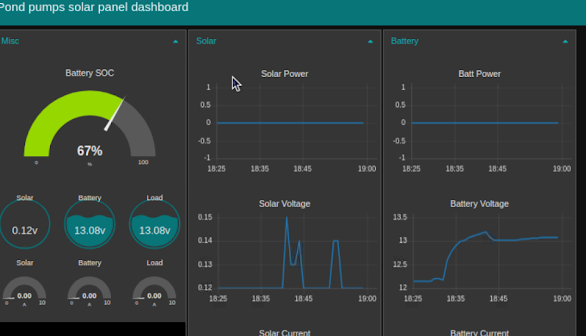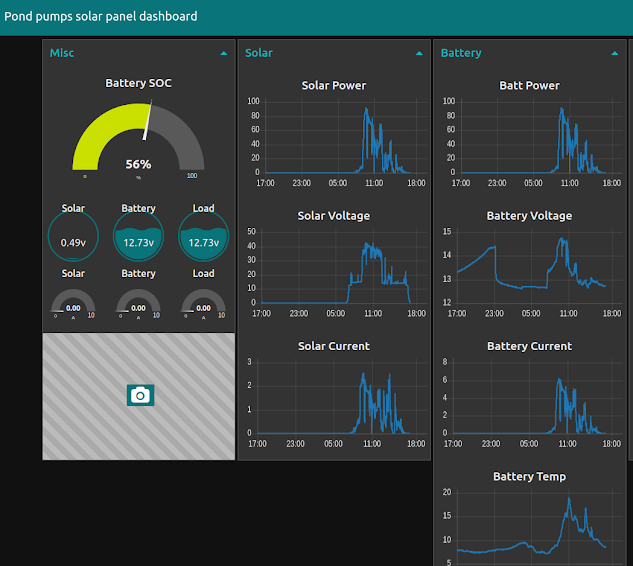Solar powered pond - part 5
learning lessons or lessons learnt?
Ingenius idea.... may or may not be viable?
I was watching the cycle of the battery being charged by solar panels (in November!) and then discharging by being used. This was during the day and it was rather novel as shown below (the variance around midday was due to me fiddling around with the cabling)
As I was looking at this daily data, it got me to thinking.... that tailing off of power at the end of the day, that's not good, is it? I mean it's been great during the day, you see the batteries getting filled up, you see them being used / discharging, then up again and then down again...oh, then it got dark... and they carried on going down... and then they hit 12.3v and the ATS kicked in and switched the power over to 240v mains power. Ah, so the battery is currently at 12.3v, powering the inverter, so that will trickle down into the 12.1v range over a few hours... and then the battery starts to enter dangerously low territory. 12v and lower and we end up knackering the battery. But, there is all night left to go and if, a big if, there is nice daylight tomorrow morning, it'll start to charge everything back up, but that might not be until 09:00 or so.... hmmmm.....this is not ideal.
Okay, so I'm thinking that I need to increase CAPACITY - more batteries, more batteries = more storage and therefore should take longer to drain. However, it is night time, in November (7degrees C too!)
Then I had a thought... I use a C-TEK5 trickle-charge device to keep the car battery topped up in my Jag - as that doesn't like to be without regular power (or usage) and that has special cycles to keep it topped up etc... I wonder....
So, I connected the C-TEK charger up to the battery and the power plug into the extension cable from the mains - hmmmmm....(need to double check I connected to the right thing in a minute), the theory being when the ATS switches over to the mains power, it then powers the C-TEK charger, that then starts to re-charge the battery and then when the battery hits 13.1v, the ATS will switch from the mains power to the battery power and use the battery until it drains down to 12.3v and then the ATS will switch over to the mains again and repeat that cycle... therefore, whilst in the dark, the battery is being re-charged and then dis-charged - I'm sure there is probably a better way to do this and I'm sure I'll be doing it that way next week. However, for now....
And here's the charts after 10minutes of charging:
As you can see, it took about 10mins to charge the battery up and then that drop-off is when the ATS switched over and the battery started to dis-charge. My theory is that the C-TEK will be disconnected whilst the dis-charge occurs, if that is true then the battery will not be being charged whilst it is being used, so I should see a downward discharge of volts over time.
However, on this chart, it shows the battery actually going upwards slightly...
okay, I need to go check that the C-TEK is not continuing to charge whilst I'm using the battery - that would defeat the object of the task.......
In theory though, the logic is sound - let's see how it pans out.
The reality is though, I should have more capacity to store more power and then use that. I'll re-connect the extra battery tomorrow and we'll see how that works out.
I am still reluctant to switch over to the £300 Lithium battery yet! I will do at some point, but until I've got all this worked out, I'm not risking that battery.
Hmmmm...it was as I feared, the C-TEK charger was on "all" the time, not what I was planning for. I switched it off.. but I have an idea for tomorrow....
Well, tomorrow morning was a bit of a surprise!
...and that is with the battery being used to power the pond pumps too. wow, it kinda seems to be working. I saw this image and thought it looked a little too familiar:Annoyingly, figuring this stuff out and getting it all to work, is a little "addictive"... I'll get there though.
UPDATE:









Comments
Post a Comment